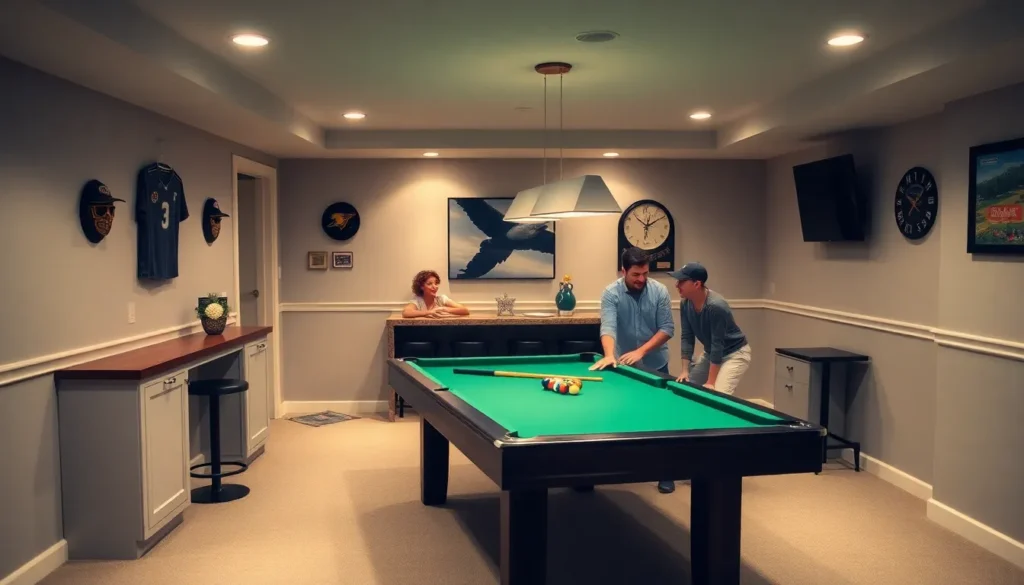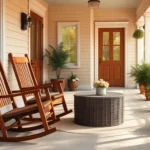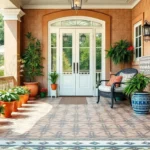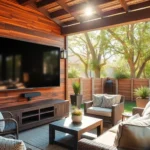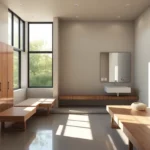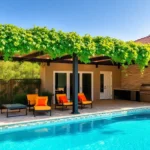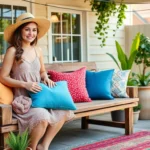Transforming your basement into the ultimate pool table room can turn that underutilized space into the crown jewel of your home entertainment setup. We’ve all dreamed of having that perfect game room where friends gather for hours of competitive fun and memorable moments.
Creating the ideal basement pool table room isn’t just about finding space for the table – it’s about crafting an atmosphere that combines functionality with style. From proper lighting that eliminates shadows on your shots to strategic storage answers for cues and accessories, every detail matters in designing a space that’ll become your home’s social hub.
Whether you’re working with a spacious finished basement or planning to renovate an unfinished area, we’ll explore creative design ideas that maximize your space while staying within budget. The right combination of flooring, wall treatments, and ambient lighting can transform your basement into a professional-quality game room that rivals any upscale billiards hall.
Planning Your Basement Pool Table Room Layout
Designing your basement pool table room starts with careful layout planning to ensure optimal gameplay and comfortable movement throughout the space.
Measuring Space Requirements for Pool Tables
Calculate the minimum room dimensions by adding 10 feet to both the length and width of your pool table. A standard 8-foot table requires a room that’s at least 18 feet by 14 feet for comfortable cue movement. We recommend measuring ceiling height as well since you’ll need at least 7.5 feet of clearance for proper overhead lighting installation.
Consider cue length when determining space needs because standard 58-inch cues require 5 feet of clearance on all sides of the table. Short cues measuring 48 inches can reduce this requirement to 4 feet if your basement has space constraints. Wall-mounted cue racks help maximize floor space while keeping equipment organized and accessible.
Account for furniture placement by mapping out seating areas, storage cabinets, and entertainment centers before finalizing your layout. Bar stools, lounge chairs, and side tables need adequate clearance from the playing area to prevent interference during games.
Choosing the Right Pool Table Size
Match table size to your available space rather than choosing the largest option that technically fits. An 8-foot table works best in rooms measuring 18×14 feet or larger, while 7-foot tables suit spaces around 17×13 feet. We’ve found that 9-foot tournament tables require rooms of at least 19×15 feet for comfortable play.
Consider player skill levels when selecting table dimensions since beginners often prefer smaller tables for easier shot-making. Recreational players typically enjoy 7-foot or 8-foot tables, while serious enthusiasts gravitate toward 8-foot or 9-foot options. Family rooms benefit from 7-foot tables that accommodate players of varying abilities.
Factor in basement ceiling height because low ceilings can make larger tables feel cramped and limit overhead lighting options. Standard 8-foot ceilings work well with any table size, but 7-foot ceilings may require careful light fixture selection to avoid head clearance issues.
Creating Traffic Flow Around the Game Area
Design clear pathways connecting the stairs, seating areas, and other basement features without crossing the primary playing zone. We position the pool table away from high-traffic areas like bathroom entrances or storage room doors to prevent gameplay interruptions.
Establish designated zones for different activities by creating distinct areas for playing, spectating, and socializing. Seating arrangements should offer good viewing angles without interfering with cue movement, while beverage stations remain easily accessible from both playing and lounging areas.
Plan electrical and lighting placement to avoid ceiling-mounted obstacles in player movement zones. Track lighting, pendant fixtures, and recessed options should illuminate the table evenly while maintaining proper head clearance around the entire perimeter.
Lighting Solutions for Your Basement Pool Table Room
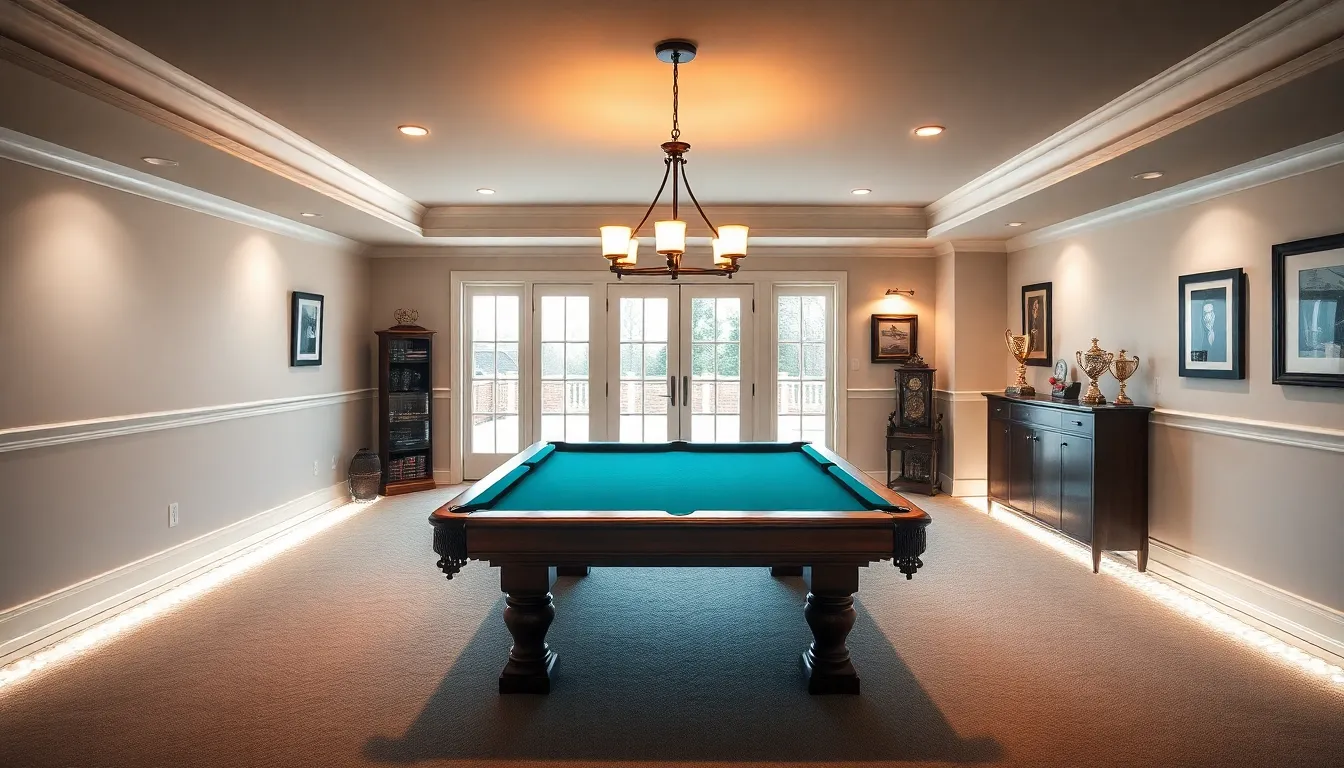
Proper lighting transforms your basement pool table area from a dim corner into a vibrant entertainment space. We’ll explore essential lighting strategies that enhance both gameplay and atmosphere.
Installing Proper Pool Table Lighting
Positioning your pool table lights directly above the playing surface ensures even illumination without creating shadows or glare. Traditional billiard lights feature multi-light pendant fixtures with adjustable height settings, allowing you to customize the brightness for optimal gameplay.
Centering the fixture over your pool table provides the most consistent light distribution across the entire playing surface. We recommend maintaining enough overhead clearance so the fixture doesn’t interfere with cue stick movements while staying close enough to deliver ample illumination for precise shots.
Choosing the right fixture style complements your basement’s overall design while serving its functional purpose effectively.
Adding Ambient Lighting Options
Layering different light sources creates depth and flexibility in your basement pool table room beyond the focused table lighting. Recessed lighting, wall sconces, and LED strip lighting along baseboards or shelving provide excellent ambient options that enhance the room’s overall mood.
Installing dimmable lights or multiple light sources gives you control over brightness levels for various occasions, from casual practice sessions to lively social gatherings. This flexibility allows you to adjust the atmosphere based on your entertainment needs.
Highlighting architectural features, bar areas, or décor elements like artwork and trophies with accent lights creates a cohesive entertainment space that feels professionally designed.
Maximizing Natural Light Sources
Incorporating available windows or glass doors brightens your basement pool table room when natural light is limited. Window treatments that maximize daylight while reducing glare on the pool table surface help balance natural and artificial lighting effectively.
Using reflective surfaces such as mirrors or light-colored walls distributes natural light throughout the space, making your basement feel larger and more welcoming. These design elements amplify existing light sources without additional electrical work.
Considering architectural additions like skylights or light wells increases daylight penetration in some basement configurations, though these options require more extensive renovation planning.
Flooring Options That Enhance Your Pool Table Room
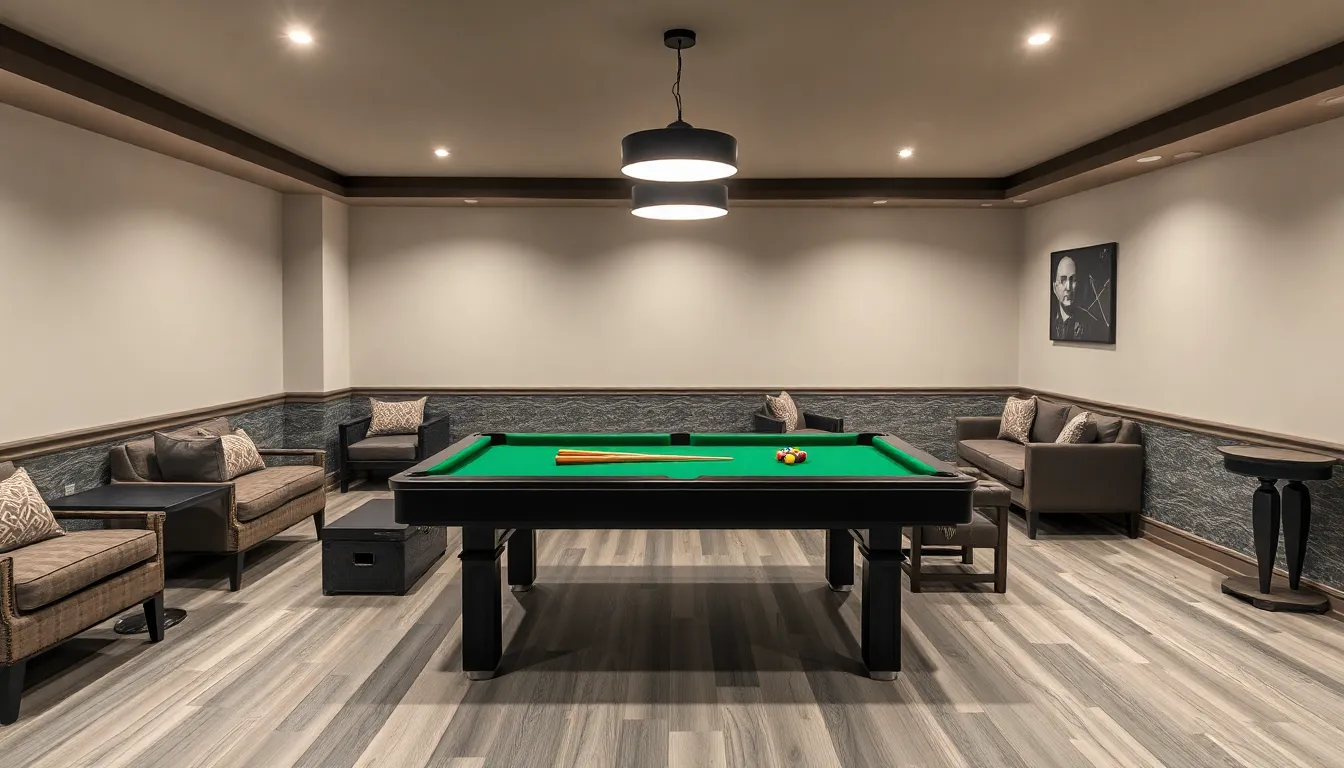
Choosing the right flooring creates the foundation for optimal gameplay while improving your basement’s overall aesthetic appeal. We’ll explore how different flooring materials can transform your pool room into a functional entertainment space.
Carpet vs. Hard Surface Flooring
Carpet flooring provides exceptional comfort for extended gaming sessions with its cushioning properties and noise reduction capabilities. Standing for hours during competitive games becomes more comfortable on carpeted surfaces, while the material naturally absorbs sound to create a quieter playing environment. But, carpet presents challenges with consistent ball roll and can accumulate dust, stains, and moisture over time in basement environments.
Hard surface flooring delivers the sleek appearance and easy maintenance that serious pool players prefer. Materials like hardwood, laminate, and engineered wood support consistent ball movement across the floor while offering superior moisture resistance compared to carpet. These surfaces reflect sound and feel cold underfoot, but you can address these issues by incorporating area rugs around seating zones or adding rubber mats near the table.
Moisture-Resistant Flooring Materials
Vinyl plank flooring stands out as our top recommendation for basement pool rooms due to its exceptional moisture resistance and realistic wood appearance. This material handles humidity fluctuations without warping while providing the durability needed for active game rooms with frequent foot traffic.
Ceramic and porcelain tiles offer unmatched water resistance and come in countless design options to match your room’s aesthetic. These materials clean easily after spills and maintain their appearance even though high humidity levels common in basement environments.
Sealed concrete presents a modern, industrial look while delivering superior moisture protection and easy maintenance. You can stain or paint concrete to achieve custom colors that complement your room’s design scheme, and the surface provides excellent stability for heavy pool tables.
Creating Defined Game Zones with Flooring
Zone definition through flooring allows you to create distinct areas within your basement pool room while maintaining visual cohesion. Install hard surface flooring directly under and around your pool table to ensure optimal ball roll, then frame this playing area with carpet or area rugs to establish comfortable seating zones.
Contrasting materials help separate your gaming area from adjacent entertainment spaces like bars or lounge areas. For example, use ceramic tile for the pool table zone and luxury vinyl planks for the bar area to create clear visual boundaries while maintaining moisture resistance throughout the space.
Pattern variations within the same flooring material can define zones without the expense of multiple flooring types. Consider running hardwood planks in different directions or using contrasting grout colors with tile to delineate your playing area from spectator zones.
Wall Design Ideas to Transform Your Basement Space
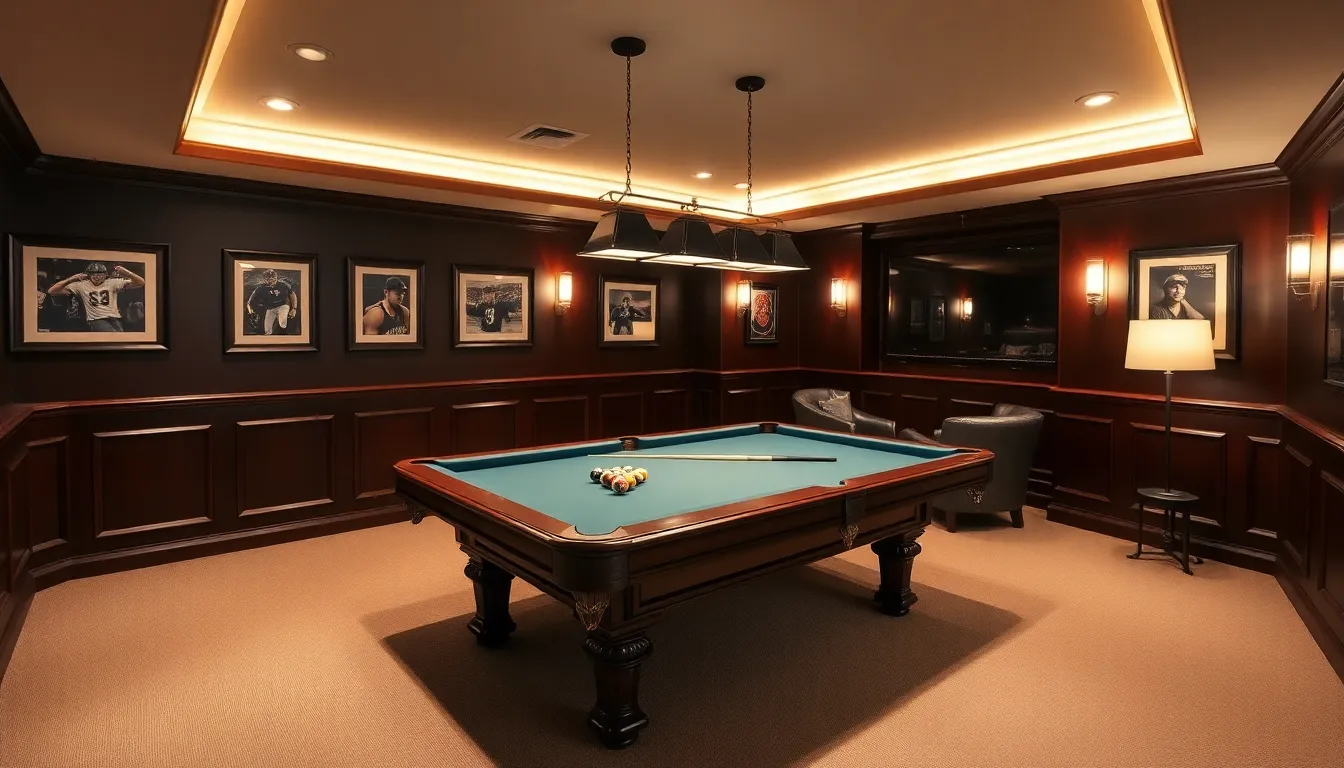
We’ll create a stunning backdrop for your pool table room by focusing on strategic wall treatments that enhance both functionality and style. Smart wall design choices can completely transform your basement’s atmosphere while complementing your game area perfectly.
Paint Colors That Complement Pool Tables
Neutral tones serve as the foundation for any exceptional pool table room, with soft tans, grays, and creams creating a balanced and elegant backdrop. We recommend exploring Sherwin Williams’ color palette, particularly SW6141 Softer Tan or SW7514 Foothills, which provide warm and inviting walls that work beautifully with most pool table finishes.
Darker shades deliver a more intimate gaming atmosphere, with deep blues and greens providing that classic sporty feel often favored in traditional billiard rooms. These rich colors create visual depth while maintaining the sophisticated ambiance that serious players appreciate.
Matte or eggshell finishes minimize glare on your pool table surface, ensuring optimal playing conditions while maintaining the room’s aesthetic appeal. Bold or contrasting paint colors on a single accent wall can effectively highlight your pool table area without overwhelming the entire space.
Adding Wainscoting and Accent Walls
Wainscoting styles like beadboard, raised panels, and shiplap add architectural interest while protecting your lower walls in this high-traffic social space. We’ve found that installing wainscoting creates depth and sophistication that elevates any basement pool room from basic to exceptional.
Accent walls painted or paneled in rich contrasting hues focus attention directly on your pool table while providing opportunities to incorporate lighting features like sconces or pendant lamps. Textured materials such as wood paneling or stone veneer create either rustic or modern looks depending on your preferred style direction.
Combining wainscoting with darker upper wall tones establishes that classic billiard room atmosphere that many homeowners desire. Built-in cabinets or shelving integrated into these wall treatments provide practical storage for billiards accessories while maintaining clean visual lines.
Incorporating Sports Memorabilia and Decor
Sports memorabilia displays transform your basement into a personalized entertainment haven, with framed jerseys, vintage pool cues, trophies, and photos celebrating your favorite sports culture. Wall-mounted cue racks enhance both functionality and visual appeal while keeping your equipment organized and easily accessible.
Strategic lighting placement highlights your memorabilia collections and creates compelling focal points around your pool table area. Vintage signs, themed artwork, and bar accessories support the authentic game room atmosphere that makes guests feel welcome and engaged.
We suggest creating dedicated display zones that don’t interfere with gameplay while showcasing your collection’s most prized pieces. Combining these personal touches with your chosen paint colors and wall treatments results in a cohesive design that reflects your personality and gaming passion.
Storage Solutions for Pool Equipment and Accessories
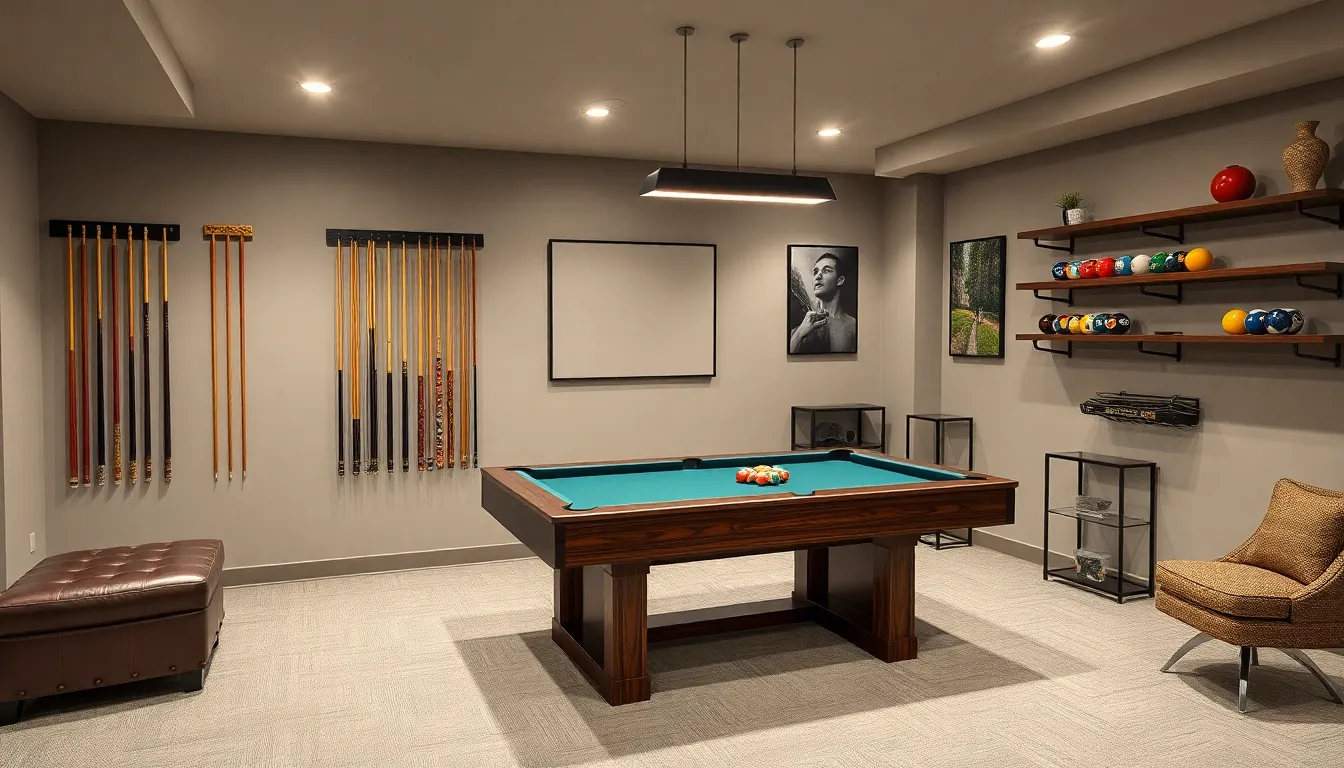
Organizing your basement pool table room requires thoughtful storage answers that keep equipment accessible while maintaining a clean, professional appearance. We’ll explore three key approaches that maximize space efficiency while improving your room’s overall design.
Built-In Cue Racks and Storage Units
Built in cue racks along your basement walls provide the most efficient way to store cues safely and neatly. Custom designed racks blend seamlessly with your room’s décor while keeping cues organized and easily accessible without creating clutter. These storage units often feature specialized compartments for chalk, gloves, and other small accessories, which enhances convenience during gameplay.
Wall mounted cue storage systems can accommodate 6-12 cues depending on your space and needs. Professional installations typically cost between $150-400 for custom wooden racks that match your existing woodwork. Consider positioning these racks away from high traffic areas to prevent accidental damage while ensuring they’re within easy reach of the playing area.
Creative Storage for Balls and Accessories
Storage for pool balls and smaller accessories benefits from creative integration that adds visual appeal to your space. Wall mounted shelves, glass front cabinets, or decorative boxes arranged in open shelving provide both function and style. Clear or labeled containers help keep balls sorted and visible while contributing to your room’s aesthetic appeal.
Display cases with LED lighting can showcase premium ball sets while protecting them from dust and damage. Rotating ball storage systems allow easy access to different sets for various games like 8-ball, 9-ball, or snooker. We recommend dedicating exact zones for different accessory types, such as a designated area for chalk stations near each corner of the table.
Multi-Purpose Furniture with Hidden Storage
Furniture pieces with hidden storage compartments serve dual purposes while maximizing your basement’s limited space. Seating with storage compartments inside or side tables that accommodate cues and balls provide practical answers without sacrificing comfort. Ottoman benches with lift up tops store accessories discreetly, maintaining your room’s clean appearance.
Storage benches positioned along walls offer seating for spectators while housing equipment like extra cues, cleaning supplies, and game accessories. Bar height tables with built in storage drawers keep scorecards, markers, and rule books organized and within reach. These multi functional pieces typically cost $200-600 depending on size and materials, making them cost effective additions that enhance both storage capacity and room functionality.
Creating a Complete Entertainment Zone
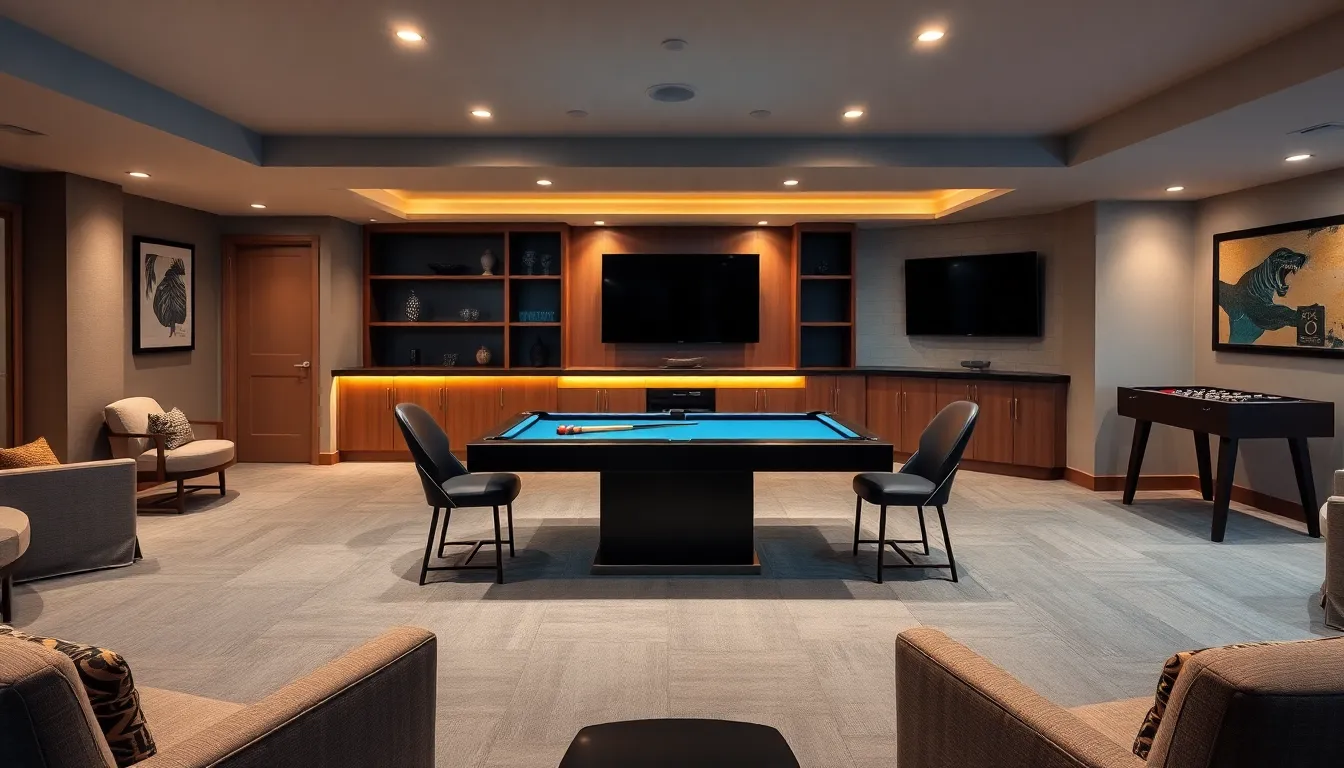
Transforming your basement into a complete entertainment zone elevates the space beyond just a pool table room. We’re combining multiple elements to create a social hub that keeps guests engaged and entertained for hours.
Adding Bar Areas and Seating Options
Bar areas serve as natural gathering spots that complement your pool table setup perfectly. We recommend installing a built-in counter with bar stools near the playing area, creating an ideal spot for guests to enjoy drinks between games. A full wet bar with storage for glassware, beverages, and bar accessories transforms your basement into a sophisticated entertainment space.
Comfortable seating arrangements encourage social interaction throughout your game room. High-back bar stools around your counter provide comfortable perches for spectators, while lounge chairs in nearby corners offer relaxation spots. We suggest positioning seating to maintain clear sightlines to the pool table without interfering with gameplay.
Strategic placement of your bar area maximizes functionality and traffic flow. Locating the bar along a wall opposite the pool table creates natural zones for different activities. This setup allows guests to move freely between playing, socializing, and refreshing their drinks without disrupting ongoing games.
Incorporating Multiple Game Tables
Multiple game tables create versatile entertainment options that cater to different interests and group sizes. We recommend combining your pool table with complementary games like foosball, ping pong, or air hockey to accommodate various preferences. Adding a card table or dartboard area expands your entertainment possibilities even further.
Space planning becomes crucial when adding multiple gaming options to your basement layout. Each table requires adequate clearance for comfortable play, so we suggest maintaining at least 4 feet of space around pool tables and 3 feet around smaller game tables. This ensures guests can move freely without bumping into equipment or other players.
Flexible arrangements accommodate different group sizes and activities throughout your entertaining sessions. Positioning tables in an L-shaped or parallel configuration creates distinct gaming zones while maintaining open pathways. We find this layout particularly effective for hosting larger gatherings where multiple games can run simultaneously.
Installing Entertainment Systems and Audio
Integrated entertainment systems enhance the gaming atmosphere with visual and audio elements that elevate your basement experience. Wall-mounted flat-screen TVs positioned away from the pool table provide entertainment during breaks while avoiding glare on the playing surface. We recommend 55-inch or larger screens for optimal viewing from various seating areas.
Surround sound speakers create immersive audio experiences without overwhelming the gaming activities. Ceiling-mounted speakers distribute sound evenly throughout the room, while wireless streaming capabilities allow easy music control from mobile devices. Installing volume controls at multiple locations lets you adjust audio levels based on activities and guest preferences.
Proper cable management maintains a clean, professional appearance in your entertainment zone. We suggest running cables through walls or using decorative cord covers to hide wiring from TVs, speakers, and gaming consoles. This attention to detail prevents tripping hazards and maintains the polished look of your basement entertainment space.
Temperature and Climate Control Considerations
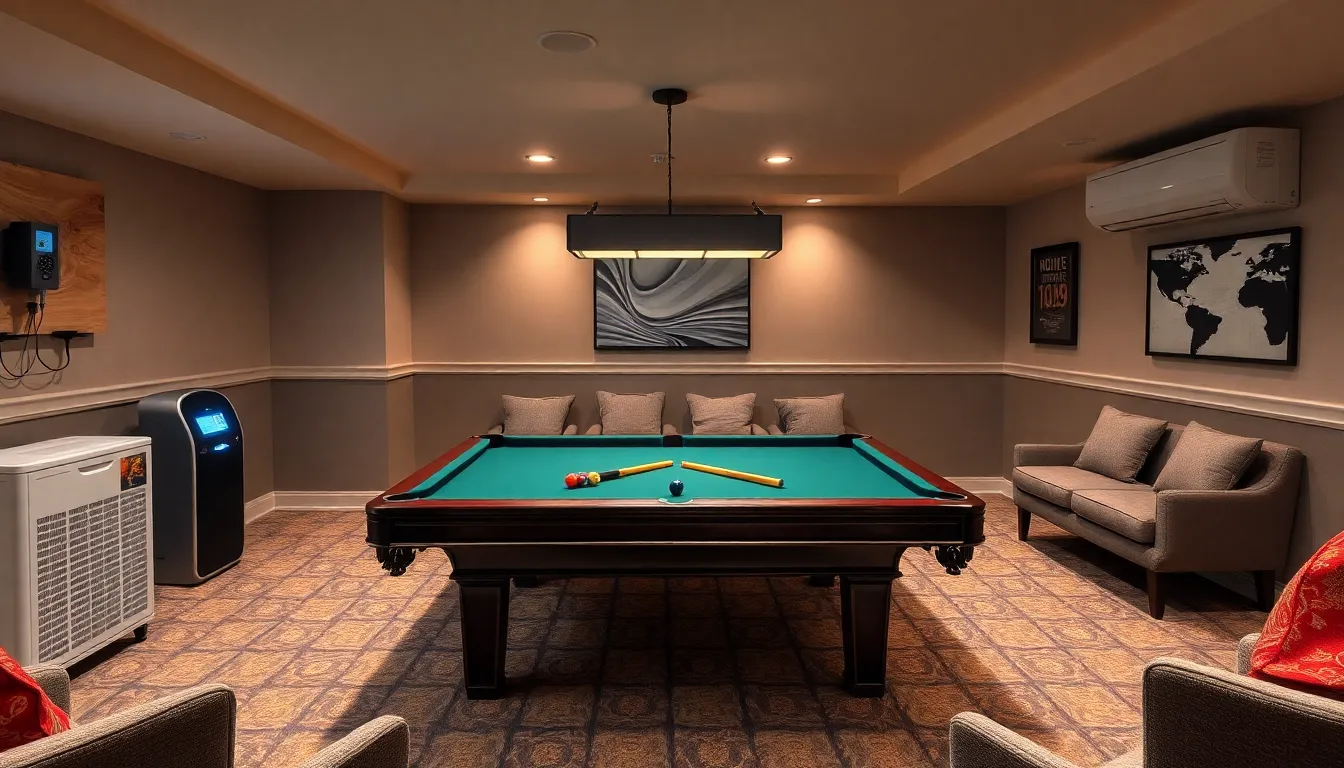
Creating the perfect atmosphere for your basement pool table requires careful attention to environmental factors that can significantly impact both gameplay and equipment longevity. Basements naturally present unique climate challenges that we must address to protect our investment and ensure optimal playing conditions.
Maintaining Proper Humidity Levels
Optimal humidity control forms the foundation of proper pool table maintenance in basement environments. We recommend maintaining relative humidity levels between 40% and 60% to prevent damage to your table’s wood components and felt surface. Excessive moisture causes wood frames to swell, warp, or develop mold growth that can permanently damage your equipment.
Installing a quality dehumidifier becomes essential in most basement pool rooms due to naturally higher moisture levels. These units actively remove excess humidity from the air and help maintain consistent conditions year round. During winter months when heating systems dry out indoor air, we may need to add moisture using a humidifier to prevent wood shrinking and cracking.
Monitoring humidity levels with a digital hygrometer allows us to track conditions and make adjustments as needed. Strategic placement of these devices near the pool table provides accurate readings of the immediate playing environment.
Heating and Cooling Answers
Temperature stability plays a crucial role in minimizing wood movement and maintaining consistent playing conditions. We should aim to keep basement pool rooms between 68°F and 72°F for optimal equipment performance and player comfort. Standard basement temperatures typically range from 55°F to 70°F, which often requires additional climate control measures.
Dedicated HVAC systems provide the most comprehensive solution for temperature and humidity control in basement pool rooms. These systems offer precise control over environmental conditions and integrate seamlessly with existing home heating and cooling infrastructure. Ductless mini split systems serve as excellent alternatives for basements without existing ductwork, providing both heating and cooling capabilities.
Portable answers like space heaters and air conditioners can supplement existing systems during extreme weather conditions. Proper insulation and sealing of basement walls enhance the effectiveness of any heating and cooling system while reducing energy costs.
Protecting Your Pool Table Investment
Pool table covers provide essential protection when tables aren’t in use, blocking dust accumulation and moisture exposure that can damage playing surfaces. We recommend investing in fitted covers made from breathable materials that allow air circulation while preventing debris buildup.
Avoiding direct sunlight exposure prevents fading of felt surfaces and eliminates temperature fluctuations that can warp wood components. Strategic window treatments and positioning help control natural light while maintaining the room’s overall brightness for gameplay.
Proper ventilation systems keep air circulating throughout the space and reduce stagnant moisture buildup that can lead to mold and mildew problems. Installing exhaust fans or ensuring adequate air exchange helps maintain fresh air quality and stable environmental conditions.
Weatherproofing measures like vapor barriers become necessary in basements prone to moisture infiltration from surrounding soil or foundation issues. These protective barriers prevent humidity from entering the room and compromising our carefully controlled environment.
Budget-Friendly Basement Pool Table Room Makeover Ideas
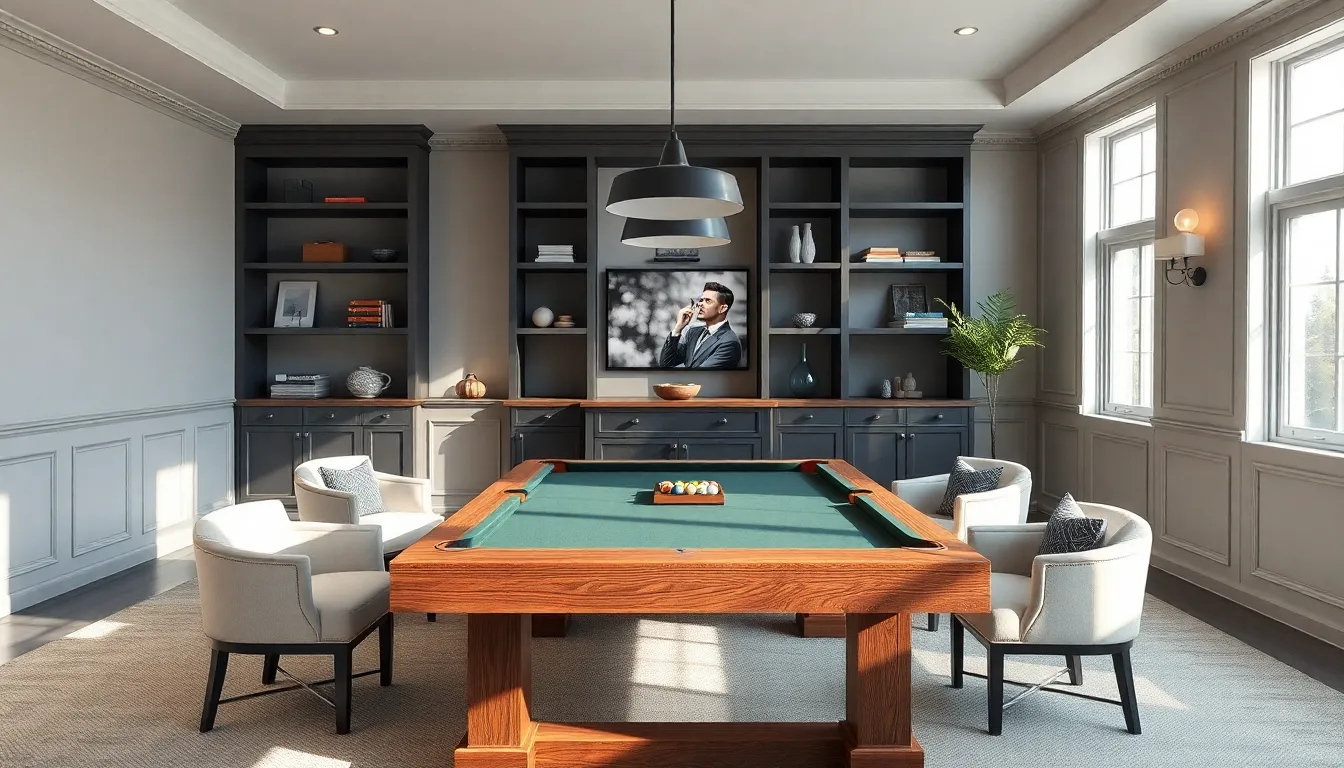
We’ve found that transforming your basement into a stunning pool table room doesn’t require very costly. Smart planning and creative answers can deliver impressive results while keeping costs manageable.
DIY Projects to Enhance Your Space
Custom shelving projects offer one of the most cost-effective ways to upgrade your pool room’s functionality and style. Building simple wall shelves from reclaimed wood provides dedicated storage for cues, balls, and accessories while adding rustic charm to your space. We recommend measuring your wall space first and creating shelves at varying heights to accommodate different items.
Wainscoting installations can dramatically elevate your room’s appearance without professional contractor costs. DIY wainscoting projects add texture and sophistication to lower walls, creating an upscale billiards club atmosphere. You’ll find that basic panel molding from your local hardware store transforms plain basement walls into elegant focal points.
Handmade wall art brings personality to your pool room while showcasing your creativity. Creating billiards-themed artwork or repurposing vintage signs and frames adds character without expensive gallery pieces. We suggest incorporating pool-related imagery, classic game room colors, and personal touches that reflect your style.
Repurposing Existing Basement Features
Existing bar areas present excellent opportunities to maximize your investment in the space. Utilizing any current bar or counter space creates a natural game room bar adjacent to your pool table, encouraging socializing while eliminating construction costs. We’ve seen homeowners successfully transform old wet bars into entertainment hubs with minimal updates.
Natural light sources can be strategically leveraged to enhance your pool table positioning and reduce lighting expenses. Arranging your table to benefit from existing windows or glass doors connects your space visually to outdoor patios while creating an open, airy feel. We recommend assessing your current window placement before finalizing your room layout.
Structural elements like support beams or built-in alcoves can become design features rather than obstacles. Converting awkward corners into storage nooks or display areas maximizes every square foot of your basement. These architectural quirks often become the most interesting aspects of finished pool rooms.
Cost-Effective Decor and Furniture Options
Minimalist decorating approaches deliver maximum impact while keeping expenses low. Using fewer but more impactful decorative pieces like statement pendant lights or vintage clocks creates sophisticated ambiance without cluttering your space. We’ve found that quality over quantity principles work exceptionally well in pool rooms.
Basic seating answers provide comfort and functionality without premium furniture costs. Simple stools or benches offer flexible seating arrangements that can be easily moved during gameplay. We recommend choosing pieces that complement your color scheme while prioritizing durability for frequent use.
Multi-purpose furniture pieces maximize both utility and value in your pool room design. Storage cabinets doubling as side tables or bar carts add essential functionality without requiring separate purchases for each need. These versatile pieces help maintain organization while contributing to your room’s overall aesthetic appeal.
Conclusion
Creating the perfect basement pool table room doesn’t have to be overwhelming when you approach it systematically. We’ve covered everything from layout planning and lighting strategies to flooring choices and climate control – all essential elements that work together to create an exceptional gaming environment.
The key to success lies in balancing functionality with style while working within your budget. Whether you’re implementing DIY storage answers or investing in professional HVAC systems your basement can become the ultimate entertainment destination that friends and family will love.
Remember that every basement is unique and the best pool table room is one that reflects your personal style while meeting your exact needs. Start with the basics we’ve outlined and gradually add features that enhance your gaming experience and create lasting memories.
Frequently Asked Questions
What is the minimum room size needed for a basement pool table?
For an 8-foot pool table, you need a minimum room size of 18 by 14 feet. This ensures adequate space for players to move around the table and make shots comfortably. Consider ceiling height as well, with at least 8 feet recommended for proper lighting installation and cue clearance during gameplay.
What type of flooring is best for a basement pool table room?
Hard surface flooring like vinyl plank, ceramic tile, or sealed concrete is ideal for basement pool rooms. These materials are moisture-resistant, easy to clean, and provide better ball roll than carpet. They also handle basement humidity better and won’t trap dust or odors that could affect gameplay.
How should I light my basement pool table room?
Position pool table lights directly above the playing surface for even illumination. Use traditional billiard lights with adjustable height settings, typically 32-36 inches above the table. Add ambient lighting with recessed lights or wall sconces to create a flexible atmosphere without interfering with gameplay.
What’s the ideal temperature and humidity for a basement pool room?
Maintain humidity levels between 40% and 60% using a dehumidifier to protect your pool table and equipment. Keep temperature stable between 68°F and 72°F with proper HVAC or portable climate control. Use fitted table covers and ensure good ventilation to prevent moisture damage.
How can I create storage solutions for pool equipment?
Install built-in cue racks that blend with your décor, or use wall-mounted systems to save floor space. Store balls and accessories in decorative boxes or display cases. Consider multi-purpose furniture like storage ottomans or benches that provide seating while hiding equipment and maintaining a clean appearance.
What are some budget-friendly ways to upgrade my basement pool room?
Try DIY projects like custom shelving from reclaimed wood or installing wainscoting for architectural interest. Repurpose existing features like old bar areas, maximize natural light to reduce lighting costs, and choose multi-purpose furniture. Use neutral paint colors and minimalist décor approaches to create style without overspending.
How do I plan the layout for optimal gameplay?
Create designated zones for playing, spectating, and socializing with clear traffic flow around the table. Ensure lighting and electrical placements don’t interfere with cue movement. Consider your skill level when choosing table size – smaller tables work better for beginners and tighter spaces while maintaining functionality.
What wall colors work best for a pool table room?
Choose neutral colors like soft tans and grays for a balanced backdrop that won’t distract from gameplay. Darker shades can create a more intimate atmosphere. Use matte or eggshell paint finishes to minimize glare on the pool table surface and ensure optimal playing conditions.

